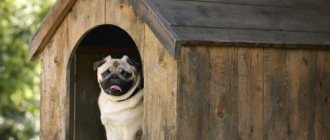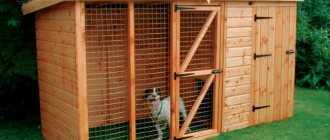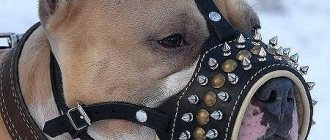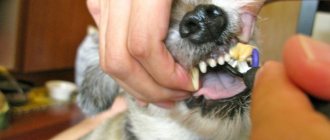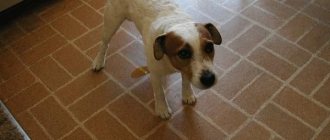Sometimes a dog does not want to settle in its own separate home - a kennel, but prefers to live in the same territory with its owners. But if the dog was bred specifically to guard the local area, such a manifestation of character can become a real problem. How to train a dog to a kennel is the topic of the article. We will learn for what reasons a dog may refuse to live in a kennel, how to eliminate this, and how to rehabilitate a capricious pet.
Why does a dog refuse to sleep in a kennel?
There are often situations when all the efforts made by the owner to accustom the pet to the booth turn out to be in vain. There are many reasons why a dog does not enter the kennel and does not sleep in it:
- The inconvenience in the booth itself is an incorrect design, drafts, cold or, conversely, it is too hot inside, an unpleasant smell.
- If the booth has been passed down from a previous pet whose smell remains in it, the animal may refuse to stay in it. This is one of the reasons why the dog does not enter the kennel even in the rain.
- The dog is afraid of the dark or does not like to be alone. This tendency is often observed in animals that have lived in the same room with household members for a long time.
- Individual characteristics of character and behavior.
Every large breed dog needs a separate room on the property.
Additional Information! In order for the animal to quickly get used to life in a booth, it is best to choose summer or spring for training. In winter and autumn, when it is cold and rainy, the animal may experience severe stress from a sudden change in living conditions, which is why it will flatly refuse to spend the night in a kennel.
Inappropriate size or uncomfortable conditions
In addition to drafts and cold, the kennel may not be the right size depending on the size of the animal. This will make him very uncomfortable.
Recommended house sizes:
| Dimensions of the animal | Booth dimensions |
| Up to 50 cm | 6 m2 |
| From 50 to 65 cm | 8 m2 |
| From 65 cm and more | 10 m2 |
For example, for a German Shepherd, a comfortable enclosure should have an average size of 1.3m*1m*0.7m.
The pet’s desire to spend the night in a separate room depends on the comfort of the created conditions.
Booth location
The booth must not only be well insulated and high enough so that water does not flood into it when it rains. It must be positioned correctly on the site. The walls should not allow drafts to pass through. With a comfortable house, the question of how to train a dog to a kennel in the yard will be easier to solve.
The pet's room should be located in such a way that the entire site, outbuildings and house can be clearly seen from it.
Attention! The booth should be located away from chicken coops and areas where livestock are kept.
The optimal location is near the fence or close to the wall so that the animal has protection from the wind and direct sunlight.
When is it time to teach?
The experience of many breeders suggests that cold weather is a good time for training in many cases. The dogs walk around the kennel, and the coolness will drive them inside the comfortable house for the night. There is also the opposite opinion - you need to train them to the booth in late spring or summer, in warm and dry weather. Bad weather will cause the dog to instinctively stay at home and training will be of little use. But light rain will not be a hindrance, but on the contrary will help - the dog will find shelter in a warm and dry booth.
The appropriate age for training is 3-4 months. The puppy must be strong enough for street life. If you live in a region with a cold climate, then postpone training until spring. In severe frosts, the puppy’s undercoat will not save you from freezing.
How it should be: requirements for “dog housing” on the street
How to train a dog to crate
In order for the animal to quickly get used to its new home, it must meet the following requirements:
- The booth should be spacious and match the size of the animal. The height of the opening should be 75% higher than the height from the ground to the pet’s shoulders.
- Good ventilation, but no drafts.
- Insulation. It is recommended to use foam or felt as insulation.
- The litter should not be small, but not large either. A pillow stuffed with cedar shavings is used as bedding. Cedar oil will repel insects with its scent. But you need to take into account that such a filler can cause an allergic reaction.
- The optimal material for making a booth is wood or plastic. The entrance is made of rubber strips, with mandatory weighting at the ends.
- The roof is sealed and dense.
- The booth must necessarily stand on legs or on a pallet. Be sure to have good ventilation inside.
Attention! Blankets, newspapers, hay and straw, and old carpet should not be used as bedding. These materials very quickly become moldy, and bedbugs and fleas infest them.
Arrangement of the “home”
To accustom a dog to a kennel, you first need to equip a new home and make it comfortable for living. Sometimes little things play an important role in the retraining process.
- A good enclosure or kennel should be spacious (depending on the size of the pet), clean and moderately dark.
- The owner must ensure that the components of the roof and walls of the enclosure fit closely to each other, eliminating the possibility of drafts during the cold season.
- Particular attention should be paid to the roof. There should be no holes in it through which water can seep in during bad weather. In order to check the reliability of the roof, it is necessary to pour a large amount of water onto it from a bucket or hose. The absence of dampness in the booth is the key to the health of the pet.
- You can teach your pet to live in an enclosure after its new home is ready. It is strictly not recommended to accustom a dog to a kennel after an apartment if the panels or boards that make up the new house have been recently painted. Otherwise, irreparable damage will be caused to the pet's health. There is no need to cover the walls and roof of the dog house with varnish or drying oil. When building a home for a pet, you need to choose dry boards.
- You can accustom your dog to an enclosure if the entrance/exit is located conveniently and is of a suitable size. It is advisable if there is a small canopy over the entrance; in case the dog wants to stick his head out. If he lives not in an enclosure, but in a kennel, then, probably, there is a need to accustom the dog to a chain, so that in the summer he can leave his hot refuge and take refuge in the shade of a tree.
- The most common material in the manufacture of dog housing is pine. You can watch a video on how to arrange everything correctly. For the roof, you should choose linoleum or roofing felt, which will ensure the reliability of the entire structure. Some dogs like to spend time on the roof of their house, so you need to arrange everything in such a way that the slope is sloping and the top point is at a height of no more than 10 cm.
- To accustom a dog to an enclosure means to build him a house in which he will live until the end of his days. The average life expectancy of pets is 10-15 years. A good design will last approximately the same amount of time.
[custom_ads_shortcode3]
Physical adaptation - raising a puppy
How to bury a dog correctly in the yard of a house
The main aspect in education is patience and perseverance. You need to be prepared for the fact that your pet will flatly refuse to be in the room offered to him.
Methods of physical adaptation:
- Do not immediately chain the animal. Do not leave him alone in the booth for a long time.
- Spend as much time as possible with your pet on the site, playing with it next to the booth. The animal should not feel lonely and abandoned.
- Place your dog's favorite toys in the house.
- As soon as the pet begins to show interest in its premises, it should be encouraged in every possible way, given a treat every time it enters the booth on its own.
- It is recommended to place a food bowl next to the booth and feed only there.
You need to be prepared that teaching an animal to have its own home will not be easy.
Training a pet will take a lot of time and effort.
The first time is the most difficult
In order to accustom your dog to a kennel in the yard, you will have to be extremely patient. Even if the pet enters it on its own during the day, and even perhaps spends some time in it, this is not an indication that it will be able and willing to spend the night there.
The first time will be the most difficult. Left alone in the yard, the pet will whine and persistently ask to come into the owner's house. You cannot give in to these plaintive provocations and give in to slack. Once you make concessions and return the animal to the premises, all further attempts to tame it will be reduced to zero.
Additional Information! If an animal squeaks non-stop, you can go out to it, calm it down, pet it, sit with it near the booth, showing by your behavior that it is not alone.
Use treats as rewards
Remember an important rule: do not force your dog into a new home. Your main task is to evoke exclusively positive associations with the enclosure in your pet
Play there with the dog and feed it. Every time the dog behaves calmly and willingly enters the enclosure, joyfully praise him with words, stroking and reward him with a treat. It is better if it is food that the animal loves very much, but rarely receives - for outstanding achievements.
Guide the dog with your hand, holding a treat, towards the entrance to the enclosure and at this moment say any command you choose for this action. These could be the words “home”, “aviary”. The main thing is to define a precise and meaningful word that you will use only in this situation.
Astrological forecast for the first week of summer 2022: relationships, work, health
Healthy food, body wraps, green tea: a mother of two lost 42 kg (photo)
A modest wife and mother of six children has turned into a spectacular beauty (photo)
You can throw pieces of treats on the ground while in the enclosure and let the dog eat them. This will also make the animal feel positive about the unfamiliar space.
How to accustom a mature dog to life on a leash
How to train a dog to wear a muzzle?
It is easier and faster to adapt a small animal to living in a booth rather than working with an already formed character.
The method of training differs between those animals that were taken from the street and those pets that lived for some time in a common area with household members.
For some pets, being on a leash can be very stressful.
If the animal is street
Before you accustom your dog to a kennel and a leash, you need to take into account that this animal does not like strong restrictions.
First, the leash should be made as long as possible so that the pet can move freely over a wide area. Gradually its length decreases.
If after the apartment
Training an animal that is used to living in the same room with members of the household and does not know what it is like to live in an open area is an extremely difficult task.
To achieve this goal, the following recommendations must be followed:
- At first, the pet should not be left alone for a long time. He should not feel as if he was abandoned.
- The time spent in the booth should be measured. At first, you need to leave the animal in its personal premises for no more than 2-3 hours, after which it should be taken to conditions that are comfortable for it.
Gradually, the time the animal spends in the booth increases.
Additional Information! The pet should not be rushed or rushed, much less left alone in unusual conditions.
Inappropriate size or uncomfortable conditions
The size of the booth should give the dog the opportunity to calmly turn around and lie down with its paws stretched out! If the booth is small, the dog will not even enter it.
The bottom of the booth is hard, which can cause discomfort to the pet. The owner’s natural desire is to create more comfortable conditions. However, at this stage you need to act wisely. You cannot place a mattress or materials that attract moisture in the booth.
The optimal bedding for the booth is late-mown, chopped hay. Benefits of hay as bedding:
- A 2–3 cm layer of hay is soft enough for comfortable sleep.
- If the weather is humid outside and the bedding is wet, the hay absorbs moisture and begins to rot.
- When hay rots, there is no unpleasant smell; it is rather sweetish.
- As hay rots, it releases heat, which is an additional source in snowy weather.
What not to do
When working to train a pet to live in a kennel, many dog breeders make a number of mistakes that absolutely should not be made:
- Forcibly force the animal to stay in its own separate room. This will cause it to experience severe stress and fear. The owner must behave very carefully and act slowly but persistently, without succumbing to pathetic tricks.
- When saying the command “Place!”, you should not overtire your pet, thinking that he will learn everything in one go.
- The animal should be rewarded for correct behavior with its favorite treats, but it should not be overly pampered.
- It is strictly forbidden to shout, much less physically punish, when the animal is inside the booth. This will cause the room to be associated with the fear of punishment, and it will never want to be there again.
Screaming and physical punishment will not lead to the desired result
When accustoming an animal to a leash, you cannot immediately put it on it. It will take some time to adapt to the site.
Training methods
It is not easy to train an adult dog to stay in a kennel. If she won't go to the kennel, the following tips will help solve the problem.
- The animal needs to be allowed to get used to it, allowed to enter a new booth, sniff the surrounding area, and wait until it gets used to the enclosure. To do this, you should gradually leave the house with him in dry, warm weather and introduce him to his future home.
- When a dog enters a new home, it is important to reward it with a treat to develop pleasant associations.
- It is worth putting several of your favorite dog toys in the kennel so that the animal can feel a familiar smell.
- When the dog is in the kennel, it is important not to forget about it and not leave it alone. A simple game and communication will reinforce positive emotions.
- It is better to accustom an animal to a new place in warm weather, since in winter being outside can become stressful for him.
The kennel or enclosure is placed facing the front door so that the owner, if necessary, can quickly assess the dog’s condition.
[custom_ads_shortcode3]
Teaching the command “Place!”
Training your dog to learn this command is quite easy. You need to put a treat in the booth and invite the animal to get it, while saying the word “Place” loudly. After repeating the manipulation several times in a row, take a short break. After some time, the fun game is repeated again, but the treat is placed in the booth every other time.
Additional Information! When teaching a command, you need to choose the right moment when the animal is in a playful mood, it is cheerful and active.
It is quite difficult to train a pet to stay in a kennel. This is a labor-intensive process that requires a lot of effort and patience. To achieve success, you need to act persistently but gently. Through joint games and treats, the owner can show that the booth is very good, comfortable and cozy.
Bad review
Contrary to popular belief, almost all guard dogs do not tolerate kennels.
The pet's logic is as follows:
- To protect the territory, it must be completely visible.
- To see the territory clearly, you need to be at the highest point.
- In order not to miss an intruder while resting, you need to lie down on the aisle.
